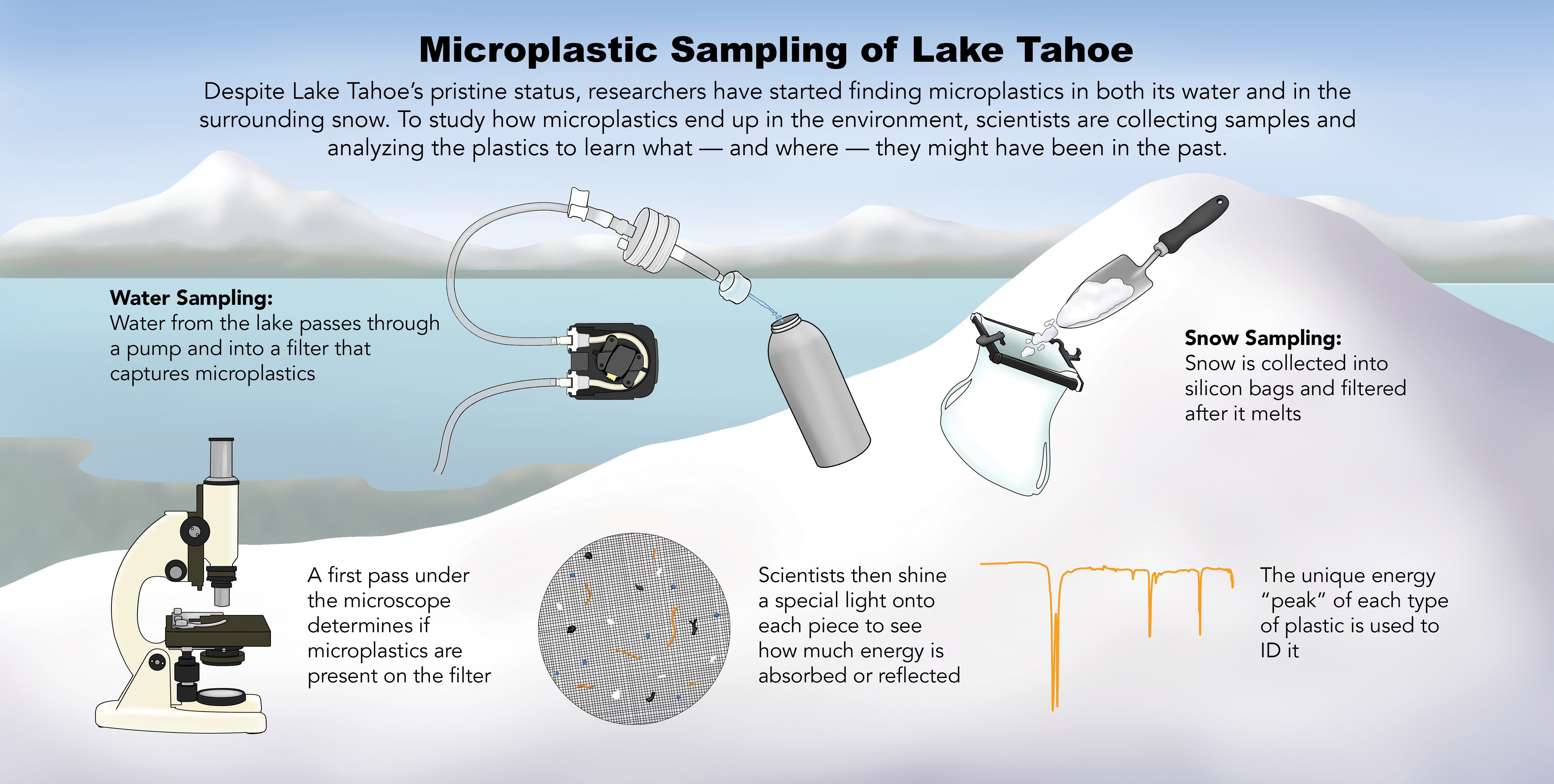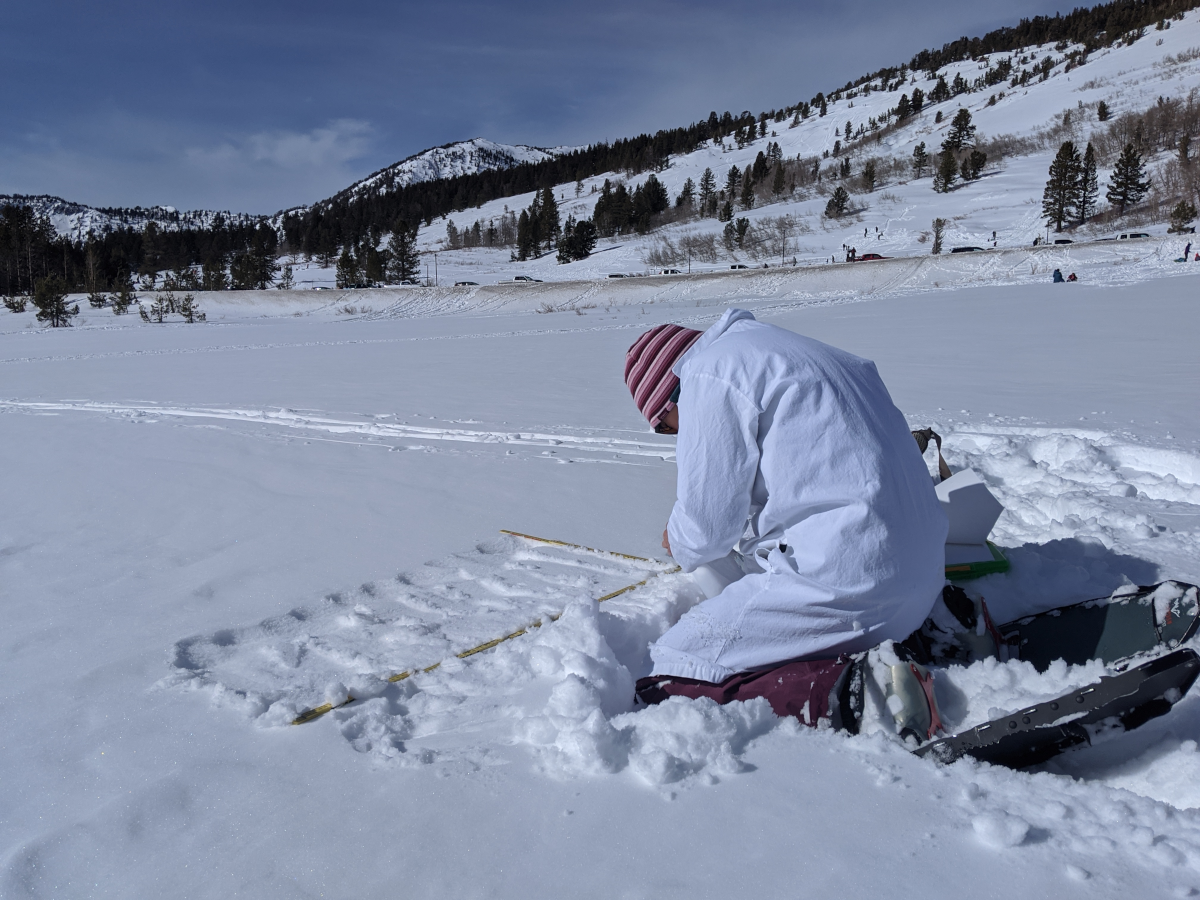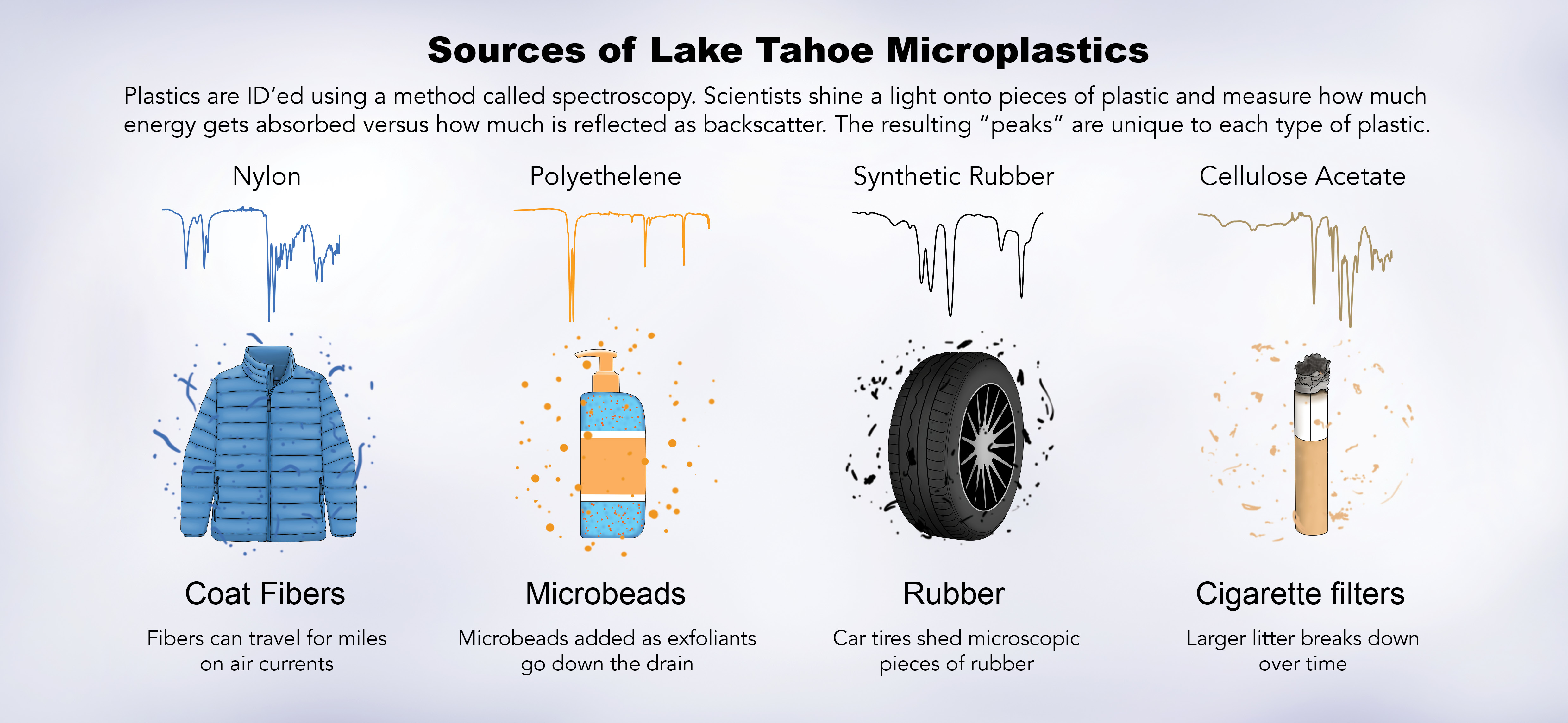Lake Tahoe’s pristine legacy threatened by microplastics
The country’s second deepest lake is renowned for its clarity, but new research reveals it is laced with an invisible pollutant. Amanda Heidt explores how scientists are tracking the sources of these plastics and what they could mean for environmental and human health. Illustrated by James Adams and Ashley Ersepke.
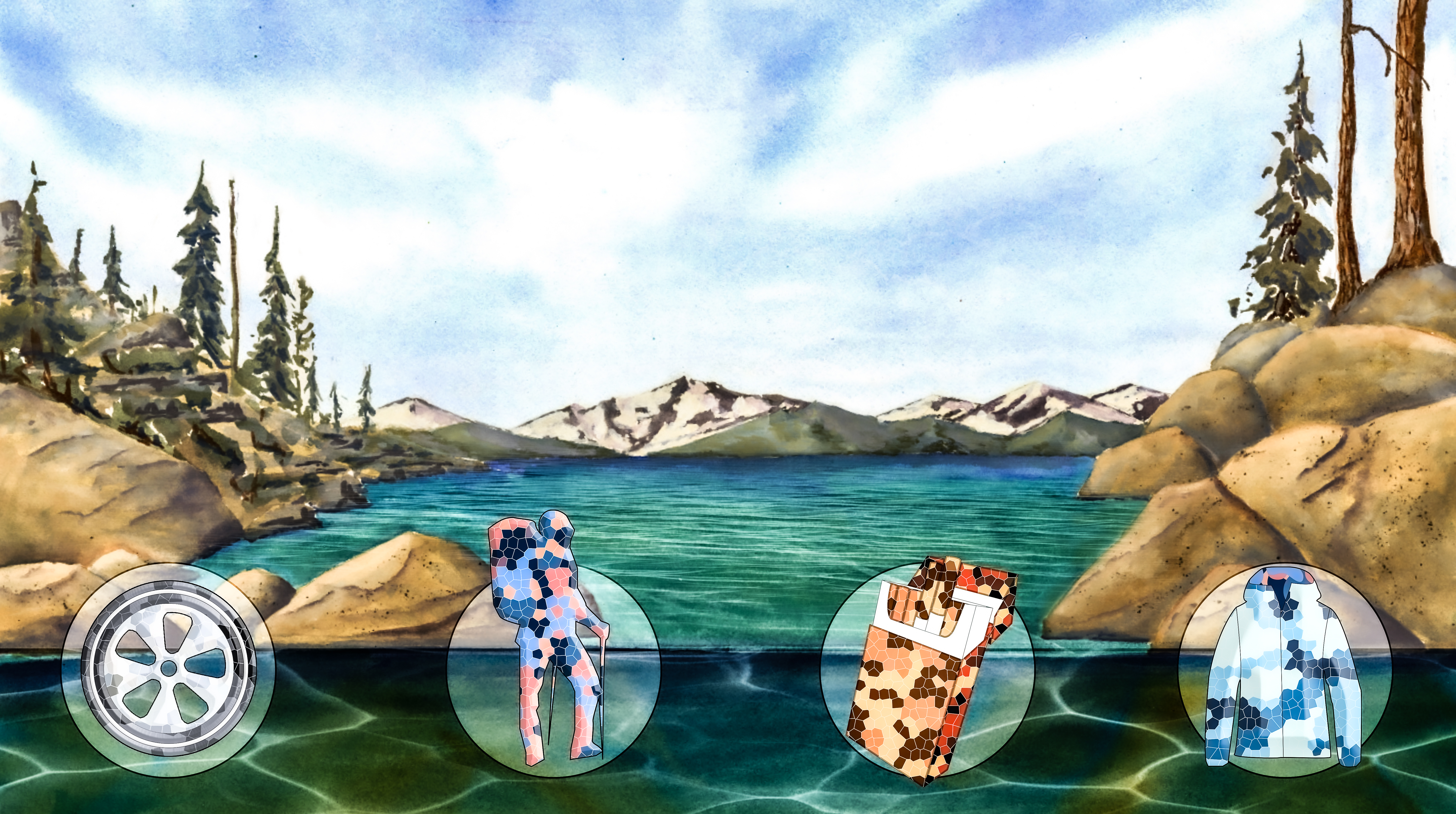
Illustration: James Adams
Sliding the strap of her snowshoe home with a click, Monica Arienzo steps out onto the pristine, windswept expanse of Tahoe Meadows, saddled between two lofty mountains near the border of California and Nevada. Breathing heavily in the thin air, we follow a pair of cross country ski-tracks through the deep powder left from a recent storm.
The scene is undeniably picturesque on a crisp and clear morning in this rugged country. But it belies a dirty truth: Lake Tahoe, the azure jewel in the valley below, is laced with microscopic bits of plastic — remnants of sleds, cigarettes and bright fibers from winter coats. As a geochemist, Arienzo suspects that at least some of the plastics begin their journey to the lake here, high above it, deposited from the air onto the surface of the snow in Tahoe Meadows.
“Every time it’s that feeling of ‘Wow, I can’t believe I’m finding this!’ to ‘Oh no, I’m finding this,’” she says, using a metal trowel to scrape a thin layer of snow into a silicon bag. “It’s really disappointing, but scientifically exciting.” Although she will need to confirm the presence of microplastics using a microscope in the lab, Arienzo seems confident of what she will find.
Nestled between mountains and guarded by strict regulations, Lake Tahoe should be pristine. But new work by Arienzo at the Desert Research Institute is highlighting a stark reality of 21st century living: microplastic pollution has spread worldwide. In the Tahoe basin, microplastics don’t just foul the water. Unexpectedly, they drift on the wind and lie hidden in snow, prompting new questions about how these particles move through the environment. The biggest question remains unanswered: How big a danger do they pose to environmental and human health?
“Material of a Thousand Purposes”
Marine scientist Ed Carpenter stumbled upon the first bellwether of this global problem when he scooped a handful of floating flecks from the remote Sargasso Sea in 1971. Realizing they were tiny bits of polyethylene plastic, Carpenter quickly published his findings in Science. It was the first time a scientist had drawn attention to microplastics in water, although reports of plastic in the stomachs of marine animals had been published throughout the 1960s.
“We know so little about [microplastic] even as we find it everywhere.”
His discovery was part of the legacy of plastic, a material first patented in 1909. Soon after World War II, plastics became a staple of prosperous living, appearing in almost every facet of daily life. Altogether, 8.3 billion metric tons of plastic was generated between 1950 and 2017, most of which continues to pile up in landfills and the environment.
The same things that make plastic so useful — its versatility, stability and durability — also allow it to persist for decades. The “Great Pacific Garbage Patch,” a massive swathe of the north Pacific Ocean twice the size of Texas, is said to contain at least 79 thousand tons of plastic waste concentrated and held in place by ocean currents.
And as large, conspicuous plastics — water bottles, flips flops and discarded fishing nets — degrade over time, they create the sesame seed-sized particles known as microplastics. Defined as pieces less than 5 millimeters in size, microplastics can also include craggy castoffs of tire rubber, exfoliating beads and fibers shed from cigarette filters or synthetic clothing.
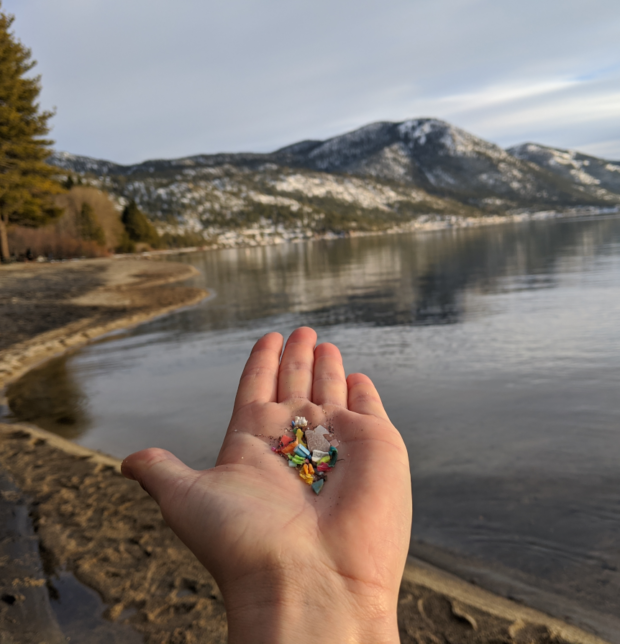
A handful of plastic waste taken from Incline Beach on the shores of Lake Tahoe. These pieces will break down further into microplastics. Credit: Amanda Heidt
Microplastics have been found in the deep sea, high on mountains and low in underground aquifers. They infiltrate seemingly remote areas such as the Arctic and the Alps, further accumulating in the wildlife that lives there. The most striking examples come from the sea, where charismatic species such as whales and turtles put a living (or not) face to plastic pollution: in 2019, a whale in the Philippines died with 88 pounds of plastic in its stomach.
But in general, much less is known about microplastics in freshwater ecosystems. Tim Hoellein, an aquatic ecologist at Loyola University in Chicago, has been tracking microplastics in lakes, streams and groundwater for several years. Studies of microplastics in freshwater systems have lagged marine studies in part, Hoellein says, because there are simply more marine scientists than freshwater scientists.
However, garbage in the ocean often arrives there through the rivers and streams that drain to the sea, a link that researchers have now begun to investigate. “It’s the role of people who work in rivers and lakes to make sure that we speak up and say that they are also reactive, retentive and dynamic ecosystems in their own right,” Hoellein said.
Hunting an Invisible Pollutant
Arienzo knew about this growing field when she attended the 2018 POLAR Conference in Switzerland, where a study of microplastic pollution in Arctic sea ice prompted her to examine the problem in her own backyard. “Seeing that paper really felt like, ‘Wow, this is something important,’” Arienzo said.
Returning home to Reno, with Lake Tahoe only an hour away, she couldn’t shake the idea of microplastics in the lake, one of the country’s most well-regulated bodies of water. Tahoe has a reputation for being pristine — its clarity widely touted via “Keep Tahoe Blue” bumper stickers — but she had also seen the trash on local beaches and the castoffs from the region’s world-class ski industry.
Working with other DRI researchers, she developed a portable water pump capable of being packed into remote field locations. Cheaper and more compact than the nets used to sample for plastics in the past, the pump works by repeatedly pinching and relaxing a length of hose — similar to a throat when swallowing — to move water through a series of silver dollar-sized filters that capture microplastics of different sizes.
In the spring of 2019, Arienzo’s team sampled water at six beaches along Lake Tahoe, choosing heavily developed sites such as the Tahoe Keys and more sheltered areas like Emerald Bay, which lies inside a state park. Arienzo also sampled both the upper and lower Truckee River — the main artery bringing water to and from Lake Tahoe — to see what types of plastics were being carried in and if the same plastics were then washing out the other side. While they did not find microplastics in every single sample, they did find them across all six sites.
But following a hunch, she also asked colleagues to collect snow opportunistically when they were out in the field performing other research duties. They brought back samples from a small handful of sites from around California. Arienzo returned the favor; the day we visited Tahoe Meadows, Arienzo was herself collecting samples for a friend.
The findings from those early samples would ultimately shift the trajectory of her study on how microplastics get to Lake Tahoe.
The Dirty Lowdown
Having found microplastics in her water samples, Arienzo next looked at snow melt under the microscope in the spring of 2019. She was preparing to leave for an evening appointment when curiosity compelled her to peek at a sample from a research facility called Sagehen, perched on the mountains above Lake Tahoe. The space was closed to the public, so it should have been clean. But what she saw amazed her.
“It was astounding the number of fibers I was seeing,” Arienzo said; she eventually counted 215 pieces of microplastic per liter of snowmelt. The abundance of fibers in the snow differed from her preliminary findings in water, which seemed to stem from more diverse types of plastic. She spent so much time photographing the samples that she arrived late to her appointment.
The dominance of fibers in snow over other types of plastic is a clue to how some microplastics move around. Many plastics in snow are first carried on the wind, and while one study identified a fiber in the Pyrenees mountains that came from at least 60 miles away, some researchers say they can travel much further. This mechanism was implicated in the Arctic paper that prompted Arienzo’s work, in which microplastics were found on sea ice far from land.
However, only the lightest pieces are carried this way, including synthetic fibers such as nylon, polyester and acrylic, which make up more than 60% of clothing materials today. This means that in relatively pristine places such as Tahoe and the Arctic where fibers are dominant, wind-driven transport of microplastics may be more important than usual sources such as discarded litter.
Unfortunately, comparing Tahoe to other areas is difficult because studies often use different methods. In the Arctic, for example, the team used methods similar to Arienzo to collect and filter snowmelt and to analyze the plastics’ chemical signature. However, Arienzo counted the microplastics in her samples by hand while the Arctic team used a more sensitive automated camera.
But the teams found similar amounts of microplastics in snow from Lake Tahoe and from Arctic sea ice — between 0-602 pieces per liter, with a high proportion of fibers. That’s still less than samples taken from more populated areas around Europe during the Arctic study, where samples topped 154,000 pieces per liter and were made up of more diverse types of plastic.
These findings suggest that Tahoe’s well-regulated water management system may actually be paying off. Because of policies that began diverting wastewater from the basin as early as 1960 to preserve the lake’s clarity, Lake Tahoe has skirted this major suspected source of microplastic pollution.
For now, all Arienzo can say is that microplastics are present and that fibers are common in snow. She is now comparing the microplastics found in the lake and snow to see what sets them apart. If the plastics in the lake derive from litter, she will know that trash is the main culprit. But if fibers are making their way down, she will have found an important new source of microplastic pollution to Lake Tahoe.
But even with these preliminary findings, other local researchers have found her results plausible. Katie Senft, a research associate with UC Davis’s Tahoe Environmental Research Center, first sampled Lake Tahoe’s beach sand for microplastics around the time Arienzo was getting started. She too found them to be ubiquitous. “People seem shocked that it was in Tahoe and I think we knew it was there all along, and we just confirmed it,” Senft said.
Are We at Risk?
Beyond the environmental effects, Arienzo’s findings also touch indirectly on another major concern: how might these microplastics affect wildlife and human health?
Airborne particles represent a new pathway for microplastics to enter the body. Little is known about how microplastics interact with sensitive lung tissue, but a recent study in Nature found that Danes inhale 11 particles of microplastic per hour even while indoors, and the American Lung Association has linked inhalation of particulates to health conditions such as asthma and cancer.
This is distinct from the usual way that plastic enters the body through eating. Scientists have extracted them from beer, table salt, sugar, tea and drinking water. A recent study discovered microplastics in the stool of eight adults from Europe and Japan, while another found that Americans consume more than 70,000 pieces annually.
A big concern is that microplastics might interact negatively with other contaminants in the body even if they are not themselves harmful. Studies have found that microplastics support biofilms of bacteria, some known to cause illness. And due to chemicals added during manufacturing, plastics tend to attract other contaminants, clustering toxins together and magnifying their potency. If they are absorbing and releasing these toxic chemicals, they could cause lasting damage even if the plastic itself is subsequently passed.
Environmental chemist Xuelian Bai, also of the Desert Research Institute, studies endocrine disrupting chemicals that interfere with normal hormone cycling in the body. She is researching two such chemicals, triclosan and estradiol, in Lake Mead — a highly contaminated lake in Nevada that provides drinking water for 25 million residents. Despite feeling “100% sure” that chemicals entering waterways are causing harmful effects, Bai admits that the science doesn’t support that idea — at least not yet. “We need to do a lot of research to find out more before we put in any regulatory actions,” Bai said.
By adding triclosan and estradiol to water containing plastic microbeads, Bai is now testing whether the beads absorb the compounds. She has already shown that microbeads are eaten by tiny freshwater crustaceans called Daphnia that sit at the base of many freshwater food webs, hinting at the possibility of a buildup of toxins in higher predators in a phenomenon known as “bioaccumulation.” “This exposure pathway might be very important to explain how Daphnia and other species experience toxic effects due to microplastic’s interaction with other contaminants,” Bai said.
Similarly, a study by DRI colleagues in the Las Vegas Wash — a 12-mile-long channel which feeds the Las Vegas Valley’s excess water into Lake Mead — is examining microplastics in the gut of armored catfish for evidence of bioaccumulation.
Project lead John Umek says catfish make good study species because “they’re like little vacuums along the floor…indiscriminately pulling microplastics from the bottom.” And while a risk of bioaccumulation is increased chemical toxicity, he is also curious if plastics cause physical damage by clogging fish’s gills or taking up space in the gut, signaling to fish that they are full.
The Situation is Plastic
All this work feeds into an ongoing tussle over what to do about microplastic pollution. Should researchers be studying them — taking money away from other projects — when the evidence of their harmful effects is so scant? And if they aren’t harmful, should legislation be passed to control them simply because humanity is responsible for their creation? Arienzo, like many in the field, feels these questions can only be answered by further research. “Any work anyone does in plastics right now is helping to further the field,” she said. “It’s so wide open and we know so little about it even as we find it everywhere.”
“If the only benefit is we have a healthier planet, a cleaner planet, is that really so bad?”
She is currently developing new citizen scientist initiatives as a low-cost way to pursue more exploratory efforts, including monitoring storm drain runoff for microplastics through the League to Save Lake Tahoe’s Pipe Keepers program and a new study to look at home dryer vents as a source of fibers. In addition, she is working with volunteers planning to dive the lake’s 72 miles of shoreline to clean up underwater litter.
But the American Chemistry Council, a group that represents the nation’s leading plastics manufacturers, takes a different approach. Karyn Schmidt, a senior director in the Regulatory and Technical Affairs Division, urges caution in drawing conclusions on so little data.
“It’s not a terribly interesting scientific issue,” Schmidt said of microplastic’s ubiquity in the environment. “The more interesting issue is understanding whether those particles in the environment present a risk to human health. But we have to operate based on the current state of the science.”
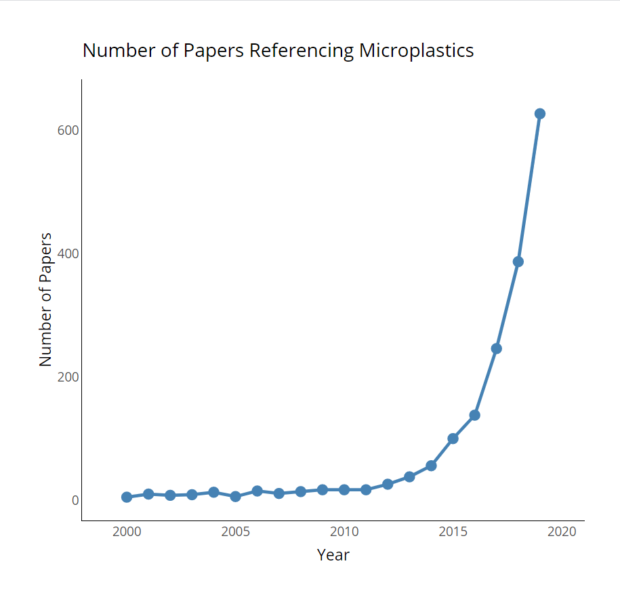
Microplastics research is a burgeoning field that has exploded in the last two decades. Credit: Amanda Heidt
The field of microplastics is still new and emerging, with the vast majority of papers published in the last decade. A recent World Health Organization report assessing microplastics in drinking water claimed that “it is not possible to draw any firm conclusions on toxicity related to microplastic exposure,” but stressed the need for further study ahead of any large-scale legislative action.
Senft, however, echoes a sentiment shared by many that regardless of their unknown impacts, microplastic pollution is a human problem that requires action. “Just because we haven’t found conclusive evidence that they’re having a negative impact on us or wildlife doesn’t mean we shouldn’t try to mitigate that problem,” she said. “If the only benefit is we have a healthier planet, a cleaner planet, is that really so bad?”
Back in Tahoe Meadows, that question is in our mind as Arienzo packs her tools and maneuvers back towards the road, where several dozen cars have crammed along the shoulder. Children pour from vehicles, brightly colored sleds in tow. As we load gear into her Subaru, a young boy nearby catches a snowball to the head, snow glinting wet across his forehead. Sharing a look, we grimace as he laughs.
© 2020 Amanda Heidt / UC Santa Cruz Science Communication Program
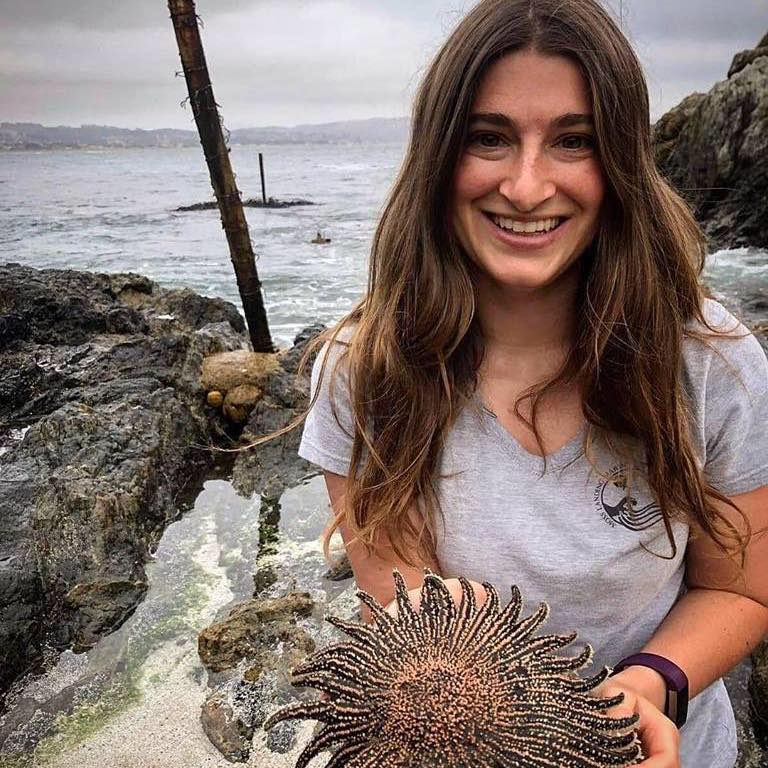
Amanda Heidt
Author
M.S. (Marine Science) Moss Landing Marine Laboratories
B.S. (Marine Biology; Minor in Chemistry) University of California, Santa Cruz
Internships: Inside Science, The Monterey Herald, Science, The Scientist
I was eight when a teacher casually mentioned that the tapioca pearls in our pudding were frog eggs. Dropped spoons clattered to the tabletop as my companions howled in disgust. Ever-curious, I wondered: was my teacher telling the truth? I needed a larger sample size to know for sure. I gathered my classmates’ rejected treats, spoon poised in the name of science.
Today, that childhood memory still sums up my relationship with science (and pudding). As a marine scientist, I am drawn to the weird and wormy, the mud dragons and water bears, those branches on the tree of life lacking the obvious charm of an otter at rest.
In writing about science, I draft a recipe for personal satisfaction and engagement with the natural world. And it might actually have frog eggs in it…
If you can believe it, I don’t have a ton of free time, but outside of my work I enjoy rock climbing, hiking, weekend-warrioring, reading, baking and talking about nudibranchs.

Ashley Ersepke
Illustrator
B.S. (Ecology and Evolutionary Biology) University of California, Santa Cruz
Internship: Alliance for a Sustainable Amazon (Madre de Dios, Peru)
Ashley is a science illustrator from San Jose, California. She earned her B.S. in ecology and evolutionary biology at University of California, Santa Cruz where she discovered her passion for science illustration.
Some of her projects at UCSC include creating murals at the Thimann Lab and Coastal Biology Campus greenhouses, contributing artwork for a book on endangered species of Santa Cruz county, and collaborating with researchers from the paleogenomics lab and NOAA to illustrate their work.
Her biggest sources of inspiration come from her personal experiences learning in undergraduate classes, studying tropical ecology abroad in Ecuador, and simply spending time in nature camping and hiking.
She is fascinated by biodiversity and the phylogenetic relationships between species, and enjoys illustrating the unique natural history traits of all kinds of creatures. In her career, she aims to highlight the beauty and wonder of the natural world while creating work that can be used for science education and wildlife conservation.

James Adams
Illustrator
B.S. (Ecology and Conservation) California State University, East Bay
Internship:
I am an artist and educator and it is my hope to inspire fascination, curiosity and stewardship of the natural world. I am intrigued by the importance of place and the connection to the landscapes that cultivate us as people. Connecting with the natural world is a doorway to better understanding ourselves as a species within the order of things.
As a child growing up, I sought wild places as a source of escape and exploration. In college, I pursued a degree in Environmental Studies and went on to become a wilderness guide and educator for many years. From leading kayaking tours through the Outer Banks of North Carolina, to climbing mountains in the Sierras and Cascades, to directing a marine science education facility for the Catalina Island Marine Institute, I seek adventure in whatever I do.
Over the years, I have found purpose in seeking a balance between the disciplines of science and art. With these tools in hand, I hope to explore Earth’s wild places and share their stories through the photos, brush strokes and words that accompany.
Now, having graduated from the Science Illustration Program at California State University, Monterey Bay, I have returned home to Bend, Oregon, where I am using my skills as an artist and scientist to teach others about the rich natural history of the Pacific Northwest.
